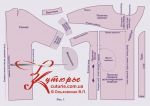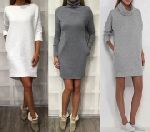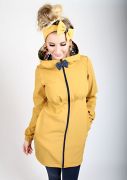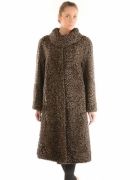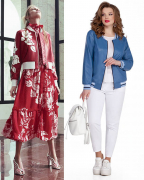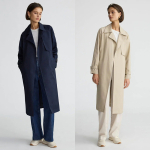Size charts What is the height of the pattern Payment methods Ask a question Reviews
An electronic pattern of a women's coat for life-size printing on a home printer or large-format plotter. Used sheets of paper for printing from A4 to A0.
 Free download instructions on how to sew a coat pattern...
Free download instructions on how to sew a coat pattern...
Instructions for a coat pattern with a one-piece sleeve and a stand - cutting and sewing with your own hands
Contents of the instruction:
- Description and complete set of patterns of women's coats.
- Description of the design of the style of the coat and what to sew.
- How to buy and download ready-made simple coat patterns with a printout on a home printer.
- Features of a do-it-yourself pattern for a women's coat of this style:
- Lobar, notches, allowances for seams, dublerin.
- How to cut a simple coat with a one-piece sleeve according to a finished pattern.
- How easy it is to sew a coat with your own hands on household sewing machines.
Description and configuration of women's coat patterns
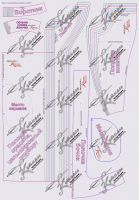 Electronic coat pattern with a one-piece sleeve and stand 40-64.
Electronic coat pattern with a one-piece sleeve and stand 40-64.
Sizes: 40-52 and 52-64 - the buyer receives all sizes of the selected gradation.
File format for download in order:
PDF in full size and without seam allowances.
After paying for the order, you will receive links to download two files coat patterns selected gradation of sizes:
- PDF A4 file adapted for printing patterns on sheets of A4 paper in any program on any device, including mobile phones.
- Multi-format PDF file for printing on sheets of any size from A0 to A4 on a printer or plotter using Adobe Reader.
The level of difficulty of sewing a simplified version without lining: medium - you will need confident skills in cutting and sewing.
The pattern is designed for sewing a coat with your own hands at home on household sewing machines. Useful devices for edging slices.
Complete set of coat patterns with a one-piece sleeve and a stand
(picture 1):
- Back pattern.
- Shelf patterns - yoke, middle + one-piece selection and barrel.
- Stand collar".
- Facing for the bottom of the sleeve.
- Burlap pocket.
- Belt.
See pattern pattern for coat details
Description of the design of the style of the coat and what to sew
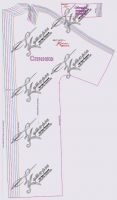 XNUMX Piece Coat Sleeve allows not only to avoid the most difficult operation for home couturiers - tucking in and sewing in the sleeves, but also to use thick enough and “complex” fabrics for sewing coats with your own hands.
XNUMX Piece Coat Sleeve allows not only to avoid the most difficult operation for home couturiers - tucking in and sewing in the sleeves, but also to use thick enough and “complex” fabrics for sewing coats with your own hands.
The design of the shelf has a tuck for the chest, so the coat will sit well on a full figure.
Using a double-sided or two-layer fabric will eliminate the need for a lining.
The pocket is located in the semi-relief seam - it is much more convenient than in the side seam.
A one-piece pick allows you to reduce the time of work on the coat and improve the quality of the processing of the sides.
What to sew a coat with a one-piece sleeve and a stand, what fabric consumption
The fabric consumption will be from 230 to 270 cm. It is important that the width of the fabric for large sizes be at least 150 cm.
For sewing, it is advisable to use double-sided cloth, drape or other dense overcoat fabric.
As mentioned earlier, two-layer fabrics that provide for sewing an unlined coat are well suited.
How to buy and download ready-made simple coat patterns with a printout on a home printer
How to choose a size without using tables and taking measurements.
How to buy a ready-made electronic pattern.
How to print a pattern at home in full size on A4 sheets or on sheets of any other format.
Buy and download this coat pattern
Features of a do-it-yourself pattern of a women's coat of this style
Lobar, notches, seam allowances, dublerin
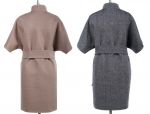 Before describing the cutting, it is worth paying attention to the position of the equity threads on the details of the coat.
Before describing the cutting, it is worth paying attention to the position of the equity threads on the details of the coat.
In the back, the front line should line up with the midline, not with the side seam, and the mid seam is required to improve the fit and to prevent the coat from sagging at the sides.
Side seams and backs, and shelves, should also not fall on the shared thread, as well as the relief seam.
And the fold of a one-piece side is always a shared one. The directions of the share for all parts are marked on the drawings.
Notches, other than "pocket", are control points that will help connect parts without distortion.
Separately, it is worth mentioning the notch along the half-slip - it marks the middle line of the coat, which should coincide with the middle line of the customer's torso. On the details of the shelf, in addition to the notches on the half-skid, you should lay a manual line with a white thread. Semi-skid marking will be needed until the product is ready.
And the last very important notch is the notch of the allowance in the right angle between the one-piece selection by the yoke line of the middle part of the shelf. This notch will allow you to turn the upper part of the bead.
Doublerin is cut out without allowances for seams along the collar and according to the patterns of the facings of the sleeves.
Seam allowances - 1 - 1,2 cm. Exceptions - the neck, the bottom of the sleeve, the flying edge of the side - seam allowances are not added for them. Bottom - 3 cm.
How to cut a simple coat with a one-piece sleeve according to a finished pattern
 Cutting has no features other than those listed above. Is it worth mentioning the collar cutting (picture 2).
Cutting has no features other than those listed above. Is it worth mentioning the collar cutting (picture 2).
The upper and lower collars are cut out in different share directions and only after the shoulder sections and sides are finally ready.
This sequence is due to the need to cut the collar of the desired length, based on the length of the neck, which can be adjusted according to your desire or due to inaccuracies in cutting and processing. Please note that such a sequence is convenient and possible only with individual tailoring and is not suitable for extras.
The share thread of the upper collar coincides with its middle line, with which it can be laid on the fold.
The lobar of the lower collar can be arbitrary, but none of the cuts should coincide with the lobar direction of the fabric.
We cut out the dubbing of the collar along the lower collar, that is, already with allowances. This ensures that during wear, the dublerin does not deform inside the collar, even if it peels off.
And one more nuance of cutting. Burlap is traditionally cut from lining fabric. But for an unlined coat, using a simplified sewing technology, you can cut a pair of burlaps from coat fabric, and the second pair from lining. Burlap made of overcoat fabric can serve as a valance for the pocket and simplify its processing.
How to easily sew a coat with your own hands on household sewing machines
Descriptions of the easiest option for sewing a coat with a one-piece sleeve without lining at home.
Sewing coats, especially on household sewing machines, is always associated with certain difficulties, the main of which is a weak presser foot spring, weak fixation of the needle bar, which is necessary to deflect the needle for zigzag and decorative stitches.
Therefore, no matter how confident you feel, all seams must be swept without distortion before sewing. After sewing, each seam should be quality ironed with steam and dried on a mannequin.
Open sections are edged with or without a binder.
Now about the coat sewing sequence:
- We grind the middle seam of the back (that is, we edging, ironing, sweeping, grinding, removing the basting, ironing - then the same operations with each seam).
- We sew burlap to the middle of the shelf, and burlap with a strip of valance (or burlap from overcoat fabric) to the barrel. The lines should “fit” between the notches and have high-quality bartacks at the ends.
- We grind fragments of the seam of the relief and burlap. Duplicate the selection and iron the selection by bending it along the line of the edge of the bead. The take-off cut of the pick-up can already be turned over.
- We sew the yoke to the middle part of the shelf.
- Next - turning a fragment of the selection in sequence. We grind and iron the turning fragment of the hem, cut out part of the allowance from the side of the hem, adjust the allowance (which is from the side of the yoke) to the hem - the line is laid from the side of the hem. We sweep the edging from the side. We iron, placing the edge of the bead towards us parallel to the edge of the ironing table and placing an ironing pad so as not to stretch the bulge of the chest.
- Stitch shoulder seams.
- We grind the side seams, not forgetting the need to delay the allowance in the rounding area before ironing the seam. The very edge of the allowance should be cut not 0,3 - 0,5 cm, depending on the width of the edging, and only after ironing it should be edged so that the edging does not tighten the stretched and cut allowance. Of course, the dissection must be covered with a border.
- Cut out the lower collar, based on the length of the neck. Duplicate and sweep.
- Perform a fitting, pinning the coat, aligning the half-skid lines on the shelves. If necessary, balance adjustment should be carried out by adjusting the neck. In addition to balance, the bottom of the product can be adjusted during the fitting. The bottom "bounces" off the floor.
- Another important point in the fitting is the marking of the loops. Well, if one of the loops falls on the level of the bulge of the chest, the other - on the most protruding point of the abdomen (especially when sewing large coats).
- After trying on, you should process the collar and facings of the bottom of the sleeve. The stitching cut of the lower collar is edged. Also duplicate the bottom allowance - a strip of 3 cm, after which the bottom can be turned over.
- The stitching of the collar has a rather long sequence - the upper collar is stitched in and stitched in, the stitching seam is ironed out, cut and trimmed, the lower collar is stitched a little higher (0,1 -0,2 cm) than the stitching seam. The lower collar is connected to the neck cut bent down and cut close to the seam of the collar. A loop of dense braid is inserted between the connected sections. It is more convenient to connect the "layers" of the collar manually with tight blind stitches, then, lay a machine line in the buttonhole area.
- Stitch the bottom of the sleeve with piping. The flying cuts of the facings should be turned over.
- Bend the bottom according to dubbing, sweep, hem with hidden stitches and iron. Thick layers at the bottom of the bead are cut out.
- Sweep loops. Sew on buttons.
- Remove notch and iron.
This is the easiest way to sew a simple coat at home on a household sewing machine with your own hands according to a finished pattern.
Download this pattern pdf:
Coat pattern with one-piece sleeve and stand
$2.00 (80 hryvnia)
Bank cards of the Russian Federation are not accepted for payment!
Size charts What is the height of the pattern Payment methods Ask a question Reviews
Vera Olkhovskaya in social networks:

-
Any pattern for free for a review of a previously made order
More...
Lifetime promotion for buyers of patterns!

Leave a review about my store of patterns for an order that you made before, and you will receive any paid pattern of your choice Free!

